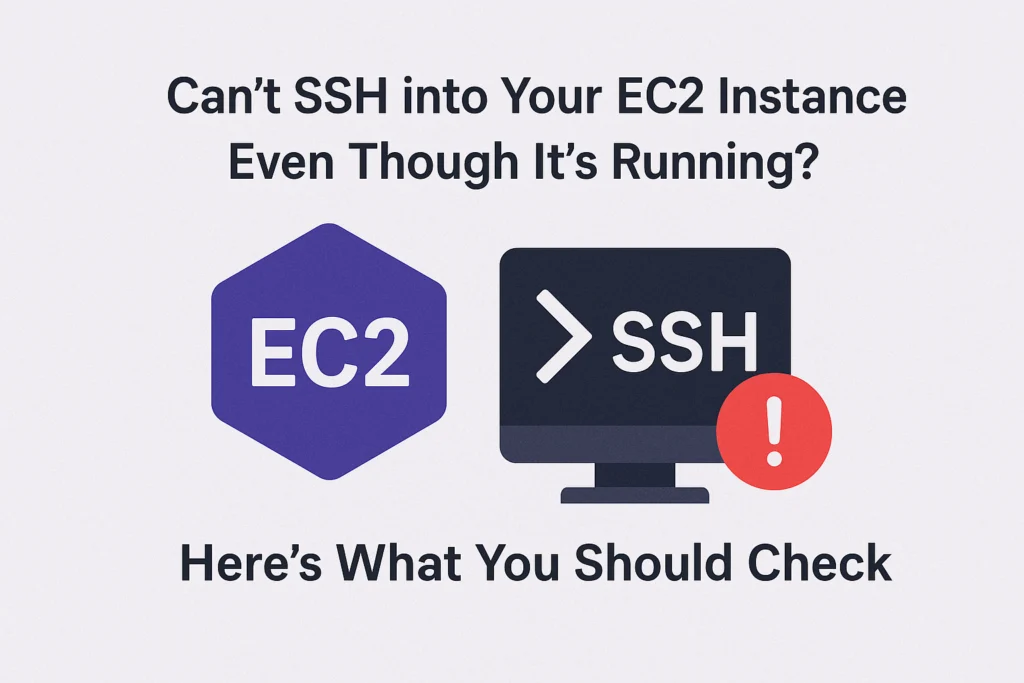Deploying projects on AWS EC2 instances can be exciting — until something goes wrong. One of the most frustrating issues I recently faced was not being able to SSH into an EC2 instance that previously worked perfectly. The instance was marked as “running” on the AWS Console, yet SSH connections failed completely.
If you’ve ever been in a similar situation, this blog post will walk you through what I experienced and what you should check when your EC2 instance is up but SSH isn’t working.
The Problem: EC2 Running, SSH Not Working
Everything was working fine I had access, I was developing, and then suddenly, SSH stopped responding.
Here’s what I knew:
The instance status was still showing as running on the AWS Console.
No obvious alerts or errors were displayed.
But when I tried to SSH:
ssh -i my-key.pem ec2-user@ec2-xx-xx-xx-xx.compute-1.amazonaws.comIt just hung or timed out.
What I Checked (and You Should Too)
1. Security Group Inbound Rules
The first thing to check is whether port 22 (SSH) is open:
Go to EC2 → Instances → Select your instance
Scroll to Security Groups
Ensure Inbound Rules have:
Type: SSH
Protocol: TCP
Port Range: 22
Source: Anywhere (0.0.0.0/0) or your IP (for security)
Even if the rules were working before, double-check — sometimes IP restrictions or accidental changes cause access issues.
2. Elastic IP or Public IP
If your instance doesn’t have a static Elastic IP, it gets a new public IP every time it’s stopped and started.
So:
Confirm you’re SSHing into the correct current IP address
Update your SSH command with the latest IP from the AWS Console
3. Key File (PEM) and Username
Double-check:
The PEM file name and path
The correct user (e.g.,
ec2-userfor Amazon Linux,ubuntufor Ubuntu)
Wrong key or wrong user = no access.
4. Instance Storage/Memory Issues
Sometimes, if your instance runs out of memory or disk, the OS may become unresponsive — SSH included — even though AWS shows it as “running.”
In my case, I realized the instance was low on memory and had likely crashed at the OS level, but AWS still marked it as active.
5. Try EC2 Instance Connect (Browser-Based SSH)
AWS provides EC2 Instance Connect, a browser-based SSH tool:
Go to EC2 → Select Instance → Click Connect
Try logging in with EC2 Instance Connect (doesn’t need your PEM file)
If this also fails, it confirms the instance is non-responsive internally.
What I Did Next
After confirming my SSH key and IP were correct, and security rules were in place, I tried EC2 Instance Connect. No luck. I still couldn’t access the instance.
At that point, I suspected a low memory crash or filesystem corruption. Since there was no way to SSH in or repair it from the outside, I:
Created a snapshot of the volume
Launched a new EC2 instance
Attached the old volume to the new instance as a secondary disk
Mounted it and copied over my project files and configurations
Set up my environment again on the new instance
It took time, but it worked.
Real Tip: Set Up Monitoring and Backups
To avoid future surprises:
Enable CloudWatch monitoring for memory and disk
Set up automatic daily snapshots
Use Elastic IP to avoid IP changes
Final Thoughts
When you can’t SSH into your EC2 instance, but it appears to be running:
Don’t panic.
Check your security group, IP address, and key file.
Try browser-based EC2 Instance Connect.
If all else fails, recover your data using snapshots and move to a new instance.
Related reads:
Other Topics:
External resources:
